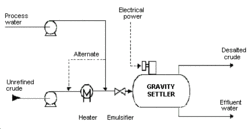Crude oil pretreatment in petroleum refining
Crude oil often contains water, inorganic salts, suspended solids, and water-soluble trace metals. As a first step in the petroleum refining process, to reduce corrosion, plugging, and fouling of equipment and to prevent poisoning the catalysts in processing units, these contaminants must be removed by desalting (dehydration).
 Electrostatic desalting. (Source: Occupational Safety & Health Administration)
Electrostatic desalting. (Source: Occupational Safety & Health Administration) The two most typical methods of crude oil desalting—chemical and electrostatic separation—use hot water as the extraction agent. In chemical desalting, water and chemical surfactant (demulsifiers) are added to the crude, heated so that salts and other impurities dissolve into the water or attach to the water, and then held in a tank where they settle out. Electrical desalting is the application of high-voltage electrostatic charges to concentrate suspended water globules in the bottom of the settling tank. Surfactants are added only when the crude has a large amount of suspended solids. Both methods of desalting are continuous. A third and less-common process involves filtering heated crude using diatomaceous earth.
The feedstock crude oil is heated to between 150° and 350° F to reduce viscosity and surface tension for easier mixing and separation of the water. The temperature is limited by the vapor pressure of the crude oil feedstock. In both methods other chemicals may be added. Ammonia is often used to reduce corrosion. Caustic or acid may be added to adjust the pH of the water wash. Wastewater and contaminants are discharged from the bottom of the settling tank to the wastewater treatment facility. The desalted crude is continuously drawn from the top of the settling tanks and sent to the crude distillation (fractionating) tower.
| Disclaimer: This article is taken wholly from, or contains information that was originally published by, the Occupational Safety & Health Administration (OSHA). Topic editors and authors for the Encyclopedia of Earth may have edited its content or added new information. The use of information from the Occupational Safety & Health Administration (OSHA) should not be construed as support for or endorsement by that organization for any new information added by EoE personnel, or for any editing of the original content. |